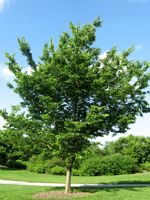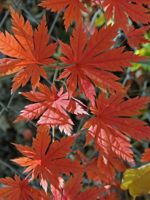Mon-Fri 9am - 5pm Mountain time
Common Hackberry vs Korean Maple
Celtis occidentalis
Acer pseudosieboldianum
NOT AVAILABLE THIS SEASON - MIGHT RETURN
The Common Hackberry is a medium-sized deciduous tree that resembles the American Elm but is immune to Dutch Elm Disease. They are versatile and can adapt to a variety of growing conditions.
It produces purple-red, berry-like fruit with a large seed in the center. Both the sweet flesh, which tastes similar to dates, and the crunchy seed are edible. The fruit remains on the tree throughout the winter, offering a valuable food source for birds and other wildlife.
The Common Hackberry can also be a great addition to a pollinator garden. The tree itself is a host for the larvae of several butterfly species and the flowers provide a source of pollen and nectar.
The Korean Maple is an ideal accent tree, and is similar in size and shape to the Japanese Maple, but much hardier. The leaves have long, finger-like lobes that turn striking shades of yellow, orange and red in autumn.
It is recommended that pruning be done during the summer after the leaves have fully developed to ensure sap does not "bleed" down the tree.

